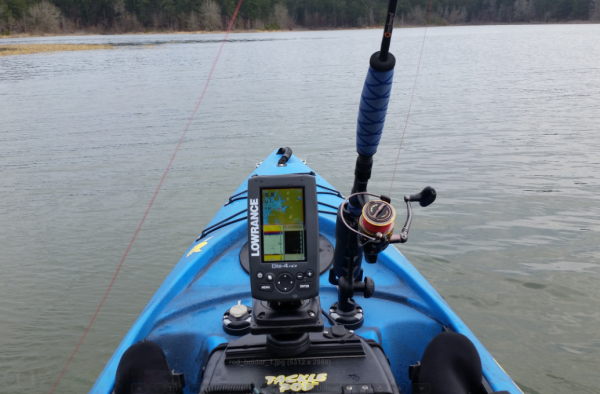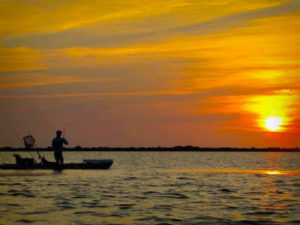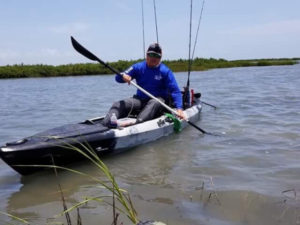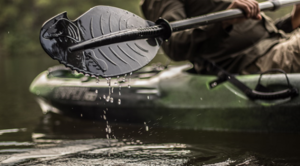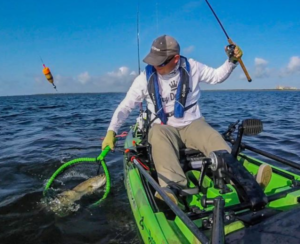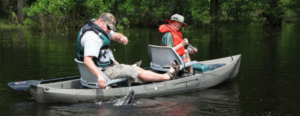Three anglers score “fishing first” in NW Ontario via Old Town® Predator PDL™ kayaks
from The Fishing Wire
Old Town, Maine Three anglers. Three days. 13 muskies. Countless big brown bass. Multi-species mayhem. The fishing trip of a lifetime.
There aren’t many “fishing firsts” left to achieve. Sure, species records are routinely set and broken, but most of what can be done, has been done. There are few new territories to explore.
Enter three intrepid anglers and a unique expedition to fish the remote fly-in-only waters of Northwest Ontario’s Sunset Country in pedal-driven kayaks… finding and catching fish with their feet… a legitimate fishing ‘first.’
With the help of Nestor Falls Fly-In Outposts, these fish-heads brainstormed a new, repeatable quest for other anglers, a contemporary take on the classic Canadian fly-in canoe fishing trip—but with the benefit of amazing engineering and unrivalled small watercraft boat control for hands-free fishing.
The adventurous anglers quickly discovered the Old Town Predator PDL a perfect boat to quickly reach (up to 5.5 mph) and efficiently explore every nuance of the untamed Canadian waters. From precisely positioning off rock islands, reefs, and weed beds, to trolling craggy shorelines and big-fish holding breaks along towering cliffs, the Predator PDL surpassed every criteria for fishability, including reverse pedal motion when they needed it to fight muskies away from cover.
Whether slinging Giant FlatSticks or flinging flies, the crew also spent a lot of time standing and fishing, eyes glued to the gin-clear depths for muskie follows.
“I was floored by the Predator PDL,” says Grant Prokop, muskie guide and owner of Thousand Lakes Sporting Goods in Cohasset, Minnesota. “We pedaled 8-12 miles a day but it didn’t seem like exercise at all, even crossing large open-water stretches in head wind. I didn’t miss anything from a big multi-species boat… the fishability and stability was just incredible. I could even figure-8.”
Considered by many the fish of 10,000 casts, muskies are notoriously hard to catch… but not so much on NW Ontario waters, as Prokop describes.
“I completely lost track of how many muskie follows we had. The three of us caught 13 in three days, which is just ridiculous. It’s pretty amazing what these fly-in lakes offer in terms of numbers. Although we didn’t land any toothy-critter past the mid-40-inches mark, we did see some bigger fish, which makes me want to go back soon!”
Hard to believe, but the gang found a lot more than muskies. Big smallmouth bass attacked X-Raps with pugilistic intensity—and a couple 20-plus-inchers were actually caught on muskie baits.
“It was a dream fishing trip, where everything came together perfectly,” says fishing writer Jim Edlund. “We’ve all been on enough trips that don’t necessarily go that way, so when they do they’re especially memorable. The multi-species action was incredible, from our very first cast to the last. And, to be honest, the fish were a bonus to the serenity of the place, the northern lights, loons, eagles, and Canadian shore lunches… it was all there… the stuff you read about in magazines as a kid come to life. And it’s cool to have been part of the first group of anglers to do a Canadian fly-in with pedal-driven kayaks. I can’t think of a better way to explore and fish remote waters. I think this opens up a whole new way to do fly-in trips.”
About the Predator PDL
- Length: 13′ 2″
- Width: 36″
- Weight: 117 lbs. (Pedal Drive: 21 lbs.)
- Carrying Capacity 500 lbs
- Forward and reverse for exact boat control in wind and current
- Smooth, quiet and easy to pedal
- Removable PDL Drive installs in seconds and tips up instantly for shallow-water docking
- Fast and maneuverable, with one-hand-operated rudder steering
- Specially-designed hull with generous width for stability and storage
- Includes accessory mounting plates, Element Seating System and other standard Predator features
- Ease of transport
- Low maintenance
MSRP $2,799.99
Like other Predator models, the Predator PDL is infinitely customizable with rigging accessories from Cannon®, Scotty™, YakAttack®, RAM®, and more.
View Online Version
JOHNSON OUTDOORS is a leading global outdoor recreation company that turns ideas into adventure with innovative, top-quality products. The company designs, manufactures and markets a portfolio of award-winning, consumer-preferred brands across four categories: Watercraft, Marine Electronics, Diving and Outdoor Gear. Johnson Outdoors’ familiar brands include, among others: Old Town® Canoes and Kayaks; Ocean Kayak™ and Necky® Kayaks; Carlisle® Paddles; Extrasport® Personal Flotation Devices; Minn Kota® Motors; Cannon® Downriggers; Humminbird® Marine Electronics; LakeMaster® Electronic Charts; SCUBAPRO® and SUBGEAR® Dive Equipment; Silva® Compasses; Jetboil® Outdoor Cooking Systems; and Eureka!® Camping and Hiking Equipment. Visit Johnson Outdoors at www.johnsonoutdoors.com


